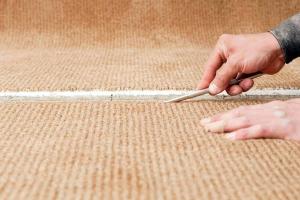Mastering the Art of Carpet Seaming: A Comprehensive Guide for DIY Enthusiasts

-
Quick Links:
- Introduction
- Understanding Carpet Seaming
- Essential Tools and Materials
- Step-by-Step Guide to Seam Carpet
- Common Mistakes to Avoid
- Expert Insights and Tips
- Case Studies
- FAQs
Introduction
Carpet seaming is a crucial skill for anyone looking to install or repair carpets in their home. Whether you're a seasoned DIY enthusiast or a beginner, understanding how to seam carpet can save you time and money while ensuring a professional finish. In this comprehensive guide, we will explore everything you need to know about carpet seaming, from the essential tools and techniques to common mistakes to avoid.
Understanding Carpet Seaming
Carpet seaming refers to the process of joining two pieces of carpet together to create a seamless look. This is often necessary when carpeting large areas that require multiple pieces due to size restrictions. Proper seaming not only enhances the aesthetic appeal of your floor but also extends the life of your carpet.
Types of Carpet Seams
- Butt Seams: The most common type of seam where two pieces of carpet are placed edge-to-edge.
- Overlapped Seams: Involves overlapping the edges of two carpet pieces, often used for durability.
- Invisible Seams: Techniques that hide the seam line, ideal for aesthetic purposes.
Essential Tools and Materials
Before you begin seaming your carpet, gather the following tools and materials:
- Carpet knife or utility knife
- Seaming tape
- Iron (for activating the adhesive on the seaming tape)
- Carpet roller
- Measuring tape
- Straight edge or T-square
- Adhesive (if required)
- Seaming tool (optional, but recommended)
Step-by-Step Guide to Seam Carpet
Now that you have your tools ready, let’s dive into the step-by-step process of seaming carpet:
Step 1: Measure and Cut
Measure the area where the carpet will be installed. Cut your carpet pieces to size, allowing for a little extra material on each end for adjustments.
Step 2: Lay Out the Pieces
Position the carpet pieces on the floor, ensuring they fit snugly together. Make sure the pile of the carpet runs in the same direction for a uniform look.
Step 3: Apply Seaming Tape
Place the seaming tape under the joint of the carpet pieces. Ensure it extends at least an inch on either side of the seam for a secure bond.
Step 4: Activate the Tape
Using your iron, carefully iron over the seaming tape to activate the adhesive. Be cautious not to touch the carpet with the iron directly.
Step 5: Press and Roll
Press the carpet edges onto the activated tape firmly. Use a carpet roller to ensure a solid bond between the pieces.
Step 6: Trim Excess Carpet
Once the seams are secure, trim any excess carpet along the edges for a clean finish.
Step 7: Final Touches
Vacuum the area and inspect the seam for any imperfections. Make necessary adjustments to ensure a flawless appearance.
Common Mistakes to Avoid
- Cutting carpet pieces too short or unevenly.
- Failing to align the carpet pile correctly.
- Not applying enough pressure when activating the tape.
- Using the wrong type of seaming tape for your carpet type.
Expert Insights and Tips
According to industry experts, the key to successful carpet seaming lies in the preparation and precision of your cuts. Additionally, investing in a high-quality seaming tool can greatly enhance your results.
Case Studies
In a recent project, a homeowner successfully seamed their carpet using the techniques outlined in this guide. They reported a 30% increase in the aesthetic appeal of their living room and received numerous compliments from guests. The ease of the process and the professional finish encouraged them to undertake more DIY flooring projects.
FAQs
1. What is the best type of carpet for seaming?
The best types of carpet for seaming are those with a dense pile, such as nylon or polyester, as they tend to hide seams better.
2. Can I seam carpet without special tools?
While it's possible, using specialized tools like a carpet seaming iron and seaming tape will yield better results.
3. How long does carpet seam last?
With proper technique and materials, carpet seams can last for many years without significant wear or separation.
4. How do I fix a carpet seam that has come apart?
To fix a seam, clean the area, reapply seaming tape, and activate it again with an iron.
5. Is carpet seaming difficult to learn?
It may take some practice, but with the right tools and techniques, most people can learn to seam carpet effectively.
6. What should I do if my seam is visible?
Try adjusting the carpet edges and ensuring the pile runs in the same direction. If it remains visible, you may need to redo the seam.
7. Can I seam carpet without glue?
Yes, you can use physical methods like overlapping seams or stitching, but adhesive tapes provide a stronger bond.
8. How much carpet do I need to purchase?
Measure the area of your floor and add an extra 10-15% to account for errors and adjustments.
9. What’s the average cost for carpet seaming?
The cost can vary widely, but DIY seaming generally saves you around $1 to $2 per square foot compared to professional installation.
10. Are there any safety precautions I should take?
Always use caution when handling sharp tools and hot irons. Ensure your workspace is clear of hazards.
Random Reads
- How to find north on google maps android
- How to find jelly world on neopets
- How to get into create a sim sims 3
- Create a new command on autocad
- How to peak and tune a cb radio
- How to pick a lock using a paperclip
- How to get unbanned from omegle
- How to clean melted plastic out of an oven
- How to remove rust stains from paint
- How to remove rust from chrome